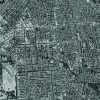Wright Street is in the south-west quadrant of the City of Adelaide and is named after John Wright, one of the South Australian Colonization commissioners who was a leading banker in the City of London in the 1820s and 1830s.
He was a director, if not the principal operative of Wright and Co., a private family business begun as early as 1699, when his great-great-grandfather, William Wright, started as a goldsmith at Covent Garden. Over five generations the family’s commercial activities evolved into a banking house which lasted for 140 years. By the time John Wright was in a position to assist the South Australian colonisation experiment, the company had grown to include several family members and relatives. In 1835 the company was formally known as Wright and Co. and its directors were John Wright, Anthony George Wright Biddulph, Henry Robinson and Edmund William Jerningham (of Jerningham Street, North Adelaide). They were all Roman Catholics and were described as bankers, dealers and chapmen.
Unlike many of the others named in the streets of Adelaide, John Wright was not especially chosen for his dedication to the project, but rather because he was well known in London both as an eminent person, a Roman Catholic and a respected banker. There was hardly a school, church or Catholic institution anywhere in Britain that did not depend in some way on a financial relationship with this famous banking house. The directors of Wrights were used to being called upon to raise large amounts of money to underwrite investment projects all over the world, and if the returns were favourable, even fanciful experiments like the Wakefield plan attracted their support.
After the passage of the South Australia Act in August 1834, William Wolryche Whitmore, the Chairman of the South Australian Association, was invited to nominate a number of potential commissioners. It was tasked to choose a politically and religiously disparate set of commissioners, so as to reflect the diversity of those intending to emigrate under the plan. This meant that beyond non-conformists, Jews and Anglicans who were known to be in support of the scheme, Catholic representation was also desirable; a point which some of the more fundamentalist aspirants and dissidents might have found difficult to accept. This would have been especially so for those, and there were many, who were of French Protestant and Huguenot extraction. Nevertheless, the logic was impeccable and the Colonial Office then began to cast around for a suitable Catholic representative.
The Wright family was highly regarded in London, carried weight in high places and, although commoners by birth, had seen several family members marry into aristocracy over three generations. Just who proposed John Wright is not known. Perhaps the most obvious clue was his connection with George Fife Angas. Both Wright and Angas were directors of the National Provincial Bank of England, Newcastle upon Tyne, a bank which Angas was instrumental in forming in 1833. Angas had been enthusiastic about Wakefield’s scheme from the outset and an inaugural member of the National Colonization Society in 1830. So he may have been called upon to suggest Catholic bankers.
There is a further point which may also reflect a personal link between the two men. Once the Commission began to sit, it soon became known that the project might falter for lack of financial support. Angas came to the rescue through the medium of his South Australian Company and Wright simultaneously raised funds outside the ‘land fund’ to cover some of the infrastructure costs such as the purchase of equipment and a surveying vessel (HMS Rapid).
Angas and Wright stood to gain financially by these actions: Wright because he was being paid a commission of £500 for providing the loan to the Commission; Angas because he was about to get a huge discount for the large number of land orders his company was prepared to purchase. According to the prospectus and the Act, both men were then obliged to stand down from the Commission because of a conflict of interest. They happily agreed.
Wright also had non-banking connections with some of the parliamentary literati of the day, which reveals his enlightened philanthropic views and which would have been seen as desirable by many at the Adelphi. Further, the Wright family moved in elevated circles. These attributes and affiliations pose plausible reasons why John Wright became involved in the South Australia project.
At the point of being named on the streets of Adelaide, John Wright was at the height of his commercial power and venerated in Adelaide because he was a commissioner. However, like so many bankers of the time, he was not really a public figure in the manner of a politician, a journalist, a reformer or a writer. In fact, he left a very small public footprint and there is not a lot of biographical material about him that is readily accessible.
Unfortunately, the economic expansion of the late 1830s was to become the nemesis for Wright and Co. The excitement of electoral reform, the growth of trade and commerce, both internationally and at home, and the speculative nature of railway company investment caused many to stumble financially. As the ‘iron horse’ pushed further and further into the hinterland, Wright and Co. somehow lost sight of good prudential practice and found themselves unable to meet the demands of some of their creditors. Towards the end of 1840 this highly respected banking house, so inextricably entwined with the Jesuits, went spectacularly bankrupt.
Thereafter, John Wright became known as ‘the once eminent after notorious banker of Covent Garden’. This was most unfortunate for Wright, who by this time was living in genteel circumstances at Heathfield House, Belsize, in Hampstead with his wife Henrietta (nee Blount), who he had married in September 1811.
The couple had three adult daughters at the time of the bankruptcy: Lucy Catherine Mary (b. 18 December 1813) was in her mid-20s; Emelie Frances Mary (b. February 1816) in her early 20s; and Juliana Mary Agnes, barely 20 years old, having been born in September 1817. Their mother Henrietta unfortunately passed away on 14 April 1839. It is tempting to speculate that Wright might have made some poor financial decisions after his wife’s death, for the company went bankrupt while he was still in mourning.
How it happened is not entirely clear, but given that the company had extended itself throughout Britain and beyond it would appear it simply had too many commitments and too little in cash reserves. By December 1840 the company was in debt for as much as £1,000,000.
Both South Australia and Wakefield’s follow-up settlements in New Zealand suffered setbacks because of this banking house. John Wright had purchased fifteen ‘town acres’ in Adelaide, Jerningham five, and both members of the Blount and Biddulph families another four. There may have been others besides these who were associated with the bankers. Wright invested capital in Wakefield’s New Zealand project and bought acres in Wellington.
Wright was also involved with the South Australian Railway Company, which was formed in 1839. The object of the company was to raise sufficient capital to construct a railway line from the ‘new port’ so as to facilitate the movement of horsedrawn carriages up to the city. With the prospectus calling for subscribers to raise £25,000 in 1,250 shares at £20 each, and there being only 150 shares reserved for the colony, the bulk of the investment was left in the hands of absentee shareholders. The most noteworthy point about this development is that Wright and Co. was not the nominated banking company for the project.
When Wrights banking house evaporated from the scene, the fallout and the repercussions reverberated for years. Fortuitously, or perhaps rather deliberately, John Wright had put the mortgage at Hillfield into his mother-in-law Catherine Blount’s name when he bought the property in 1834, so he was spared the embarrassment of losing his house. She sold the property on to a wine merchant after the bankruptcy, presumably to put a roof over the heads of her grandchildren.
Wright avoided being cast into the Debtor’s Prison and tried to make a new start. With both his health and spirit broken he spent his last years as a widower in chambers adjacent to Aldermanbury Square.
John Wright died in his chambers on 18 January 1855, aged 68.






Comments